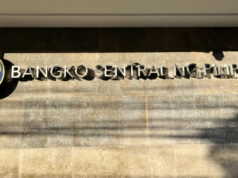Infrastructure spending target doubted
AN international think tank doubts that the government plan to sharply raise infrastructure spending is doable, citing the slow rollout of projects and concerns about the administration’s change in financing mode.

Analysts at GlobalSource Partners said that there has been little sign, so far, of the state’s capacity to implement its P8.4-trillion infrastructure spending plan over the next five years, amid uncertainty fueled by questions on the government’s change in preferred funding scheme for these big-ticket projects.
“Looking at the Duterte administration’s achievements on the infrastructure front this past year, it is hard to be optimistic that it can in fact attain its ambitious targets that would bring average 2017-22 infrastructure spending close to seven percent of GDP from only around three percent in the last six years,” economists Romeo L. Bernardo and Marie Christine Tang said in a July 14 report released on Monday.
Under the “Build, Build, Build” initiative, economic managers of President Rodrigo R. Duterte want to raise the share of infrastructure spending to 7.4% of gross domestic product by 2022, from a 4.7% share in 2016.
The analysts also cited a “problem of prioritization” in the government’s Public Investment Program (PIP) crafted by the National Economic and Development Authority. Projects listed under the PIP “are typically selected and included without the benefit of up-to-date sector master plans and without undergoing prioritization based on social desirability and finite fiscal resources,” the report read. “All the projects are in a sense ‘priority’, to be pursued when funding is available.”
GlobalSource cited concerns over the sudden about-turn of Mr. Duterte’s economic managers from public-private partnership (PPP) as the premier mode of project financing.
The Duterte government has said that it will rely more on public funding and official development assistance (ODA) to avoid delays and higher project costs, arguing that it takes an average of 30 months from conceptualization for projects to enter construction stage.
The current administration is now employing a “hybrid” model, whereby construction is financed by the government or ODA and operation and maintenance is entrusted to the private sector.
This is a marked shift from the primary reliance on PPPs for major projects in the past six years of former president Benigno S.C. Aquino III, which had made the Philippines a key example cited by multilateral lenders like the Asian Development Bank for other emerging economies to emulate.
In May, the government removed the plan to develop five regional airports from the PPP pipeline in favor of “other modes” of funding. Last December, the Philippine Ports Authority also withdrew the Davao Sasa Port redevelopment from the PPP lineup to cut costs.
The GlobalSource analysts said that the policy shift would likely add to political risks under Mr. Duterte, even as they cited the merits of other financing schemes.
“While the lack of policy continuity would add to assessments of political risk under this administration, one can in fact see the merits of de-emphasizing PPP as the principal driver of the country’s infrastructure aspirations,” according to the report.
“[N]ot many projects lend themselves to a PPP structure; and as government pursues more and more higher risk greenfield projects, a PPP arrangement may not necessarily bring value for money for government, particularly if it is forced to absorb a big share of the demand risk in order to make projects bankable.”
GlobalSource joined other observers in questioning the national government’s ability to take on these projects — citing among others lack of technical expertise — even as it assured that maintaining infrastructure spending at five percent of GDP annually will be enough to help the economy hit the official 7-8% growth goal. The government plans to spend about P847.22 billion this year on infrastructure alone, equivalent to 5.32% of GDP. — Melissa Luz T. Lopez



